engine coolant Lancia Ypsilon 2014 Owner handbook (in English)
[x] Cancel search | Manufacturer: LANCIA, Model Year: 2014, Model line: Ypsilon, Model: Lancia Ypsilon 2014Pages: 315, PDF Size: 13.18 MB
Page 8 of 315
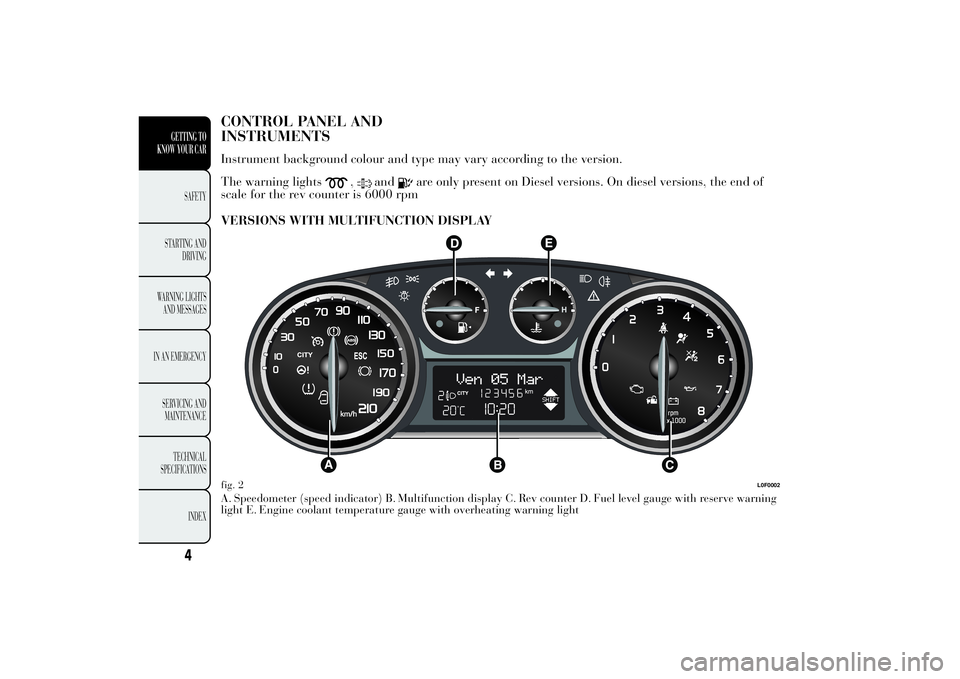
CONTROL PANEL AND
INSTRUMENTSInstrument background colour and type may vary according to the version.
The warning lights
,
and
are only present on Diesel versions. On diesel versions, the end of
scale for the rev counter is 6000 rpm
VERSIONS WITH MULTIFUNCTION DISPLAY
A. Speedometer (speed indicator) B. Multifunction display C. Rev counter D. Fuel level gauge with reserve warning
light E. Engine coolant temperature gauge with overheating warning lightfig. 2
L0F0002
4
GETTING TO
KNOW YOUR CAR
SAFETY
STARTING AND
DRIVING
WARNING LIGHTS
AND MESSAGES
IN AN EMERGENCY
SERVICING AND
MAINTENANCE
TECHNICAL
SPECIFICATIONS
INDEX
Page 9 of 315
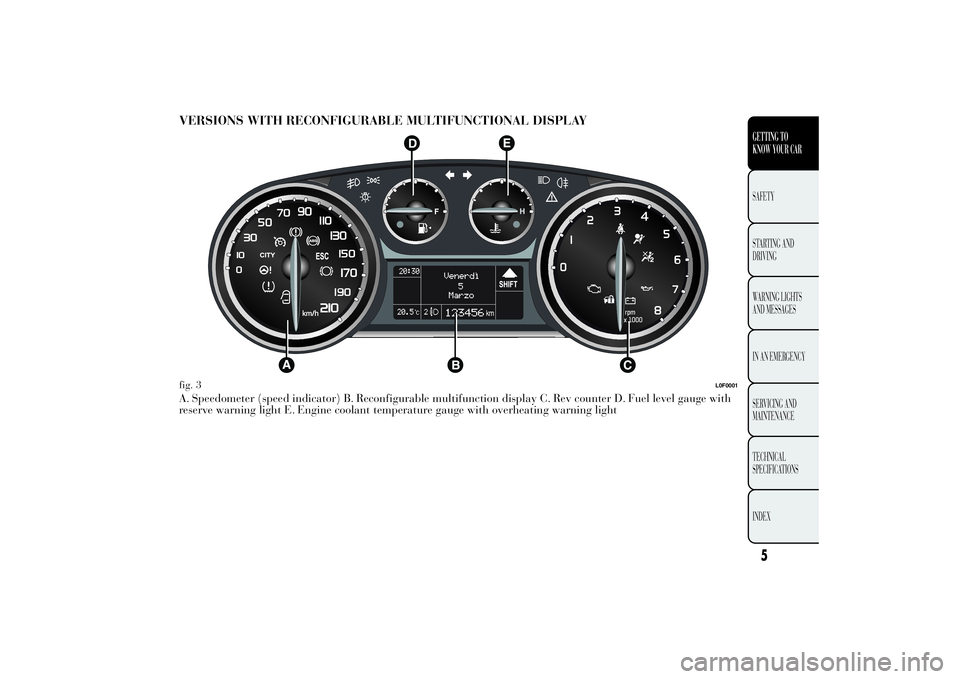
VERSIONS WITH RECONFIGURABLE MULTIFUNCTIONAL DISPLAYA. Speedometer (speed indicator) B. Reconfigurable multifunction display C. Rev counter D. Fuel level gauge with
reserve warning light E. Engine coolant temperature gauge with overheating warning lightfig. 3
L0F0001
5GETTING TO
KNOW YOUR CARSAFETY
STARTING AND
DRIVING
WARNING LIGHTS
AND MESSAGES
IN AN EMERGENCY
SERVICING AND
MAINTENANCE
TECHNICAL
SPECIFICATIONS
INDEX
Page 10 of 315
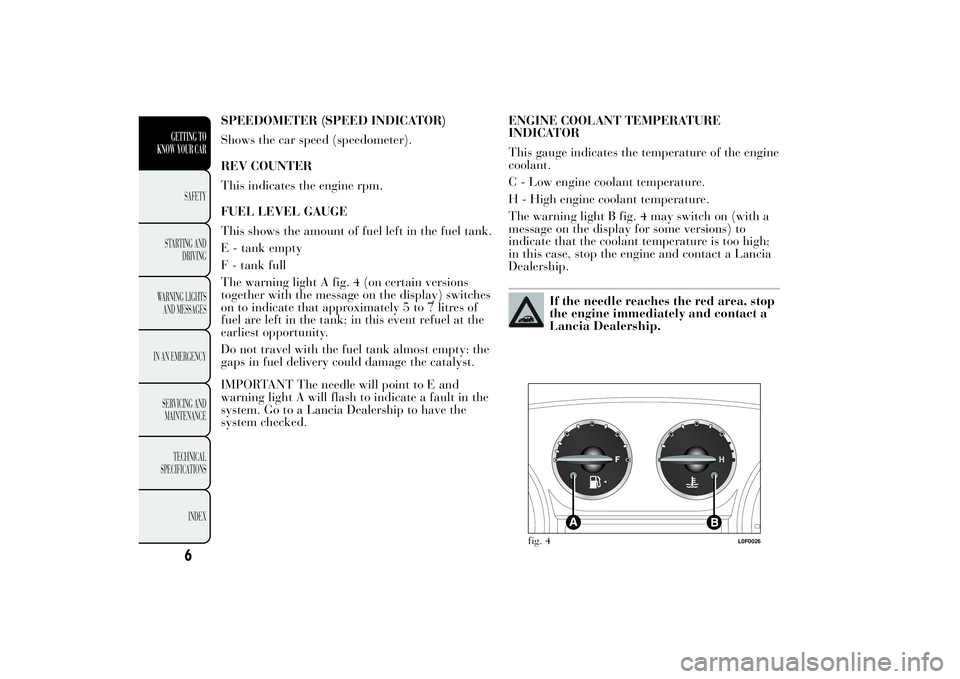
SPEEDOMETER (SPEED INDICATOR)
Shows the car speed (speedometer).
REV COUNTER
This indicates the engine rpm.
FUEL LEVEL GAUGE
This shows the amount of fuel left in the fuel tank.
E - tank empty
F - tank full
The warning light A fig. 4 (on certain versions
together with the message on the display) switches
on to indicate that approximately 5 to 7 litres of
fuel are left in the tank; in this event refuel at the
earliest opportunity.
Do not travel with the fuel tank almost empty: the
gaps in fuel delivery could damage the catalyst.
IMPORTANT The needle will point to E and
warning light A will flash to indicate a fault in the
system. Go to a Lancia Dealership to have the
system checked.ENGINE COOLANT TEMPERATURE
INDICATOR
This gauge indicates the temperature of the engine
coolant.
C - Low engine coolant temperature.
H - High engine coolant temperature.
The warning light B fig. 4 may switch on (with a
message on the display for some versions) to
indicate that the coolant temperature is too high;
in this case, stop the engine and contact a Lancia
Dealership.
If the needle reaches the red area, stop
the engine immediately and contact a
Lancia Dealership.
fig. 4
L0F0026
6
GETTING TO
KNOW YOUR CAR
SAFETY
STARTING AND
DRIVING
WARNING LIGHTS
AND MESSAGES
IN AN EMERGENCY
SERVICING AND
MAINTENANCE
TECHNICAL
SPECIFICATIONS
INDEX
Page 48 of 315

Fast windscreen and front side window
demisting/defrosting (MAX-DEF)
Proceed as follows:
❒turn knob A to the red section;
❒move slider B to
;
❒turn knob C to
;
❒turn knob E to 4 (maximum fan speed).
IMPORTANT The climate control system is very
useful for speeding up demisting since it
dehumidifies the air. Adjust the controls as
described above and press button
to activate the
climate control system (the LED on the button
will light up).ADDITIONAL HEATER
(for versions/markets, where provided)
This device speeds up passenger compartment
warming when it is very cold. The additional
heater turns off automatically after reaching the
required comfort conditions.
The heater activates automatically when knob A is
turned to the last red section and the fan is
activated (knob E turned to at least 1
stspeed).
The heater only works if the outside temperature
and engine coolant temperature are low. The
heater will not activate if the battery voltage is too
low.
SYSTEM MAINTENANCE
In winter, the climate control system must be
turned on at least once a month for about
10 minutes. Have the system inspected at a
Lancia Dealership before the summer.
44GETTING TO
KNOW YOUR CAR
SAFETY
STARTING AND
DRIVING
WARNING LIGHTS
AND MESSAGES
IN AN EMERGENCY
SERVICING AND
MAINTENANCE
TECHNICAL
SPECIFICATIONS
INDEX
Page 56 of 315

SWITCHING OFF THE CLIMATE CONTROL
SYSTEM
Press the OFF button.
The following information is shown on the
display:
❒OFF
❒internal air recirculation active indication.
SYSTEM MAINTENANCE
In winter, the climate control system must be
turned on at least once a month for about
10 minutes.
Before summer, have the system checked at a
Lancia Dealership.
The system uses R134a refrigerant
fluid which does not pollute the
environment in the event of accidental
leakage. Never use R12 fluid, which is not
compatible with the system components.ADDITIONAL HEATER
(for versions/markets, where provided)
This allows the passenger compartment to be
heated more quickly in cold weather conditions.
The heater switches on automatically according to
the environmental conditions and with engine
started when the temperature of the engine
coolant is low.
The heater switches off automatically when the
required comfort conditions are achieved.
The heater only operates if the outside
temperature and engine coolant temperature are
low. The heater will not activate if the battery
voltage is too low.
52GETTING TO
KNOW YOUR CAR
SAFETY
STARTING AND
DRIVING
WARNING LIGHTS
AND MESSAGES
IN AN EMERGENCY
SERVICING AND
MAINTENANCE
TECHNICAL
SPECIFICATIONS
INDEX
Page 57 of 315
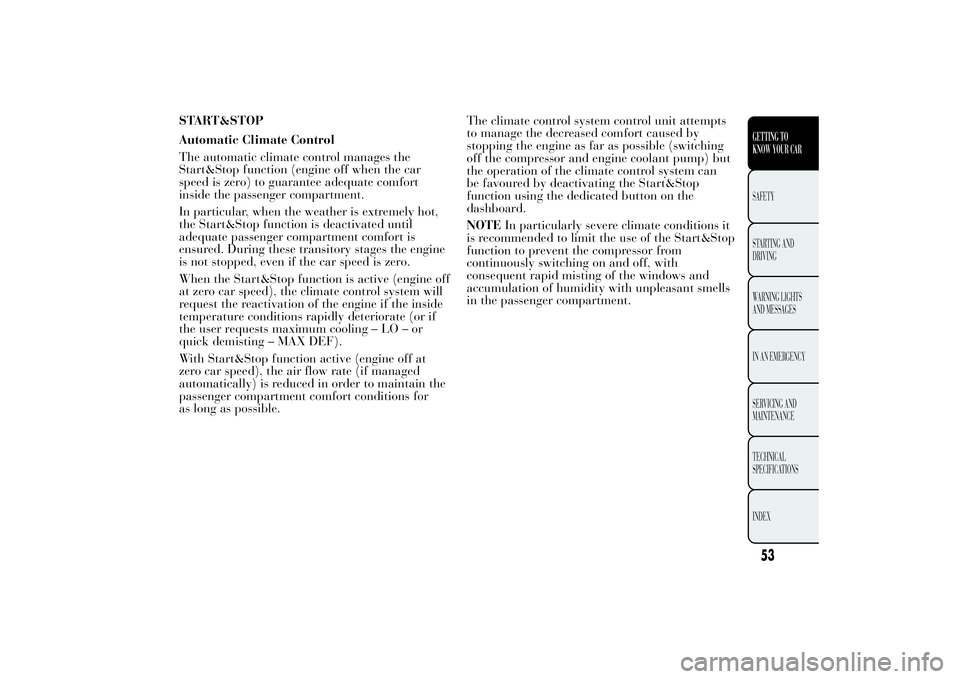
START&STOP
Automatic Climate Control
The automatic climate control manages the
Start&Stop function (engine off when the car
speed is zero) to guarantee adequate comfort
inside the passenger compartment.
In particular, when the weather is extremely hot,
the Start&Stop function is deactivated until
adequate passenger compartment comfort is
ensured. During these transitory stages the engine
is not stopped, even if the car speed is zero.
When the Start&Stop function is active (engine off
at zero car speed), the climate control system will
request the reactivation of the engine if the inside
temperature conditions rapidly deteriorate (or if
the user requests maximum cooling – LO – or
quick demisting – MAX DEF).
With Start&Stop function active (engine off at
zero car speed), the air flow rate (if managed
automatically) is reduced in order to maintain the
passenger compartment comfort conditions for
as long as possible.The climate control system control unit attempts
to manage the decreased comfort caused by
stopping the engine as far as possible (switching
off the compressor and engine coolant pump) but
the operation of the climate control system can
be favoured by deactivating the Start&Stop
function using the dedicated button on the
dashboard.
NOTEIn particularly severe climate conditions it
is recommended to limit the use of the Start&Stop
function to prevent the compressor from
continuously switching on and off, with
consequent rapid misting of the windows and
accumulation of humidity with unpleasant smells
in the passenger compartment.
53GETTING TO
KNOW YOUR CARSAFETY
STARTING AND
DRIVING
WARNING LIGHTS
AND MESSAGES
IN AN EMERGENCY
SERVICING AND
MAINTENANCE
TECHNICAL
SPECIFICATIONS
INDEX
Page 160 of 315

HOW TO WARM UP THE ENGINE AFTER IT
HAS JUST STARTED
Proceed as follows:
❒Drive off slowly, letting the engine turn at
medium revs. Do not accelerate abruptly;
❒Do not demand full performance at first. Wait
until the engine coolant temperature gauge
starts moving.
STOPPING THE ENGINE
Turn the ignition key to STOP while the engine is
idling.
IMPORTANT After a taxing drive, before turning
the engine off you should allow it to idle to allow
the temperature in the engine compartment to fall.
A quick burst on the accelerator before
turning off the engine serves absolutely
no practical purpose, it wastes fuel
and is damaging especially to turbocharged
engines.
156
GETTING TO KNOW
YOUR CAR
SAFETY
STARTING AND
DRIVINGWARNING LIGHTS
AND MESSAGES
IN AN EMERGENCY
SERVICING AND
MAINTENANCE
TECHNICAL
SPECIFICATIONS
INDEX
We recommend that during the initial
period you do not demand to full
performance from the car (e.g.
excessive acceleration, long journeys at top
speed, sharp braking etc.).When the engine is switched off never
leave the key turned to MAR to prevent
useless current absorption from
draining the battery.Never jump start the engine by
pushing, towing or coasting downhill.
This could cause fuel to flow into the
catalytic converter and damage it beyond
repair.
Page 172 of 315

2. Engine oil deteriorated
(only Diesel versions with DPF)
The warning light will flash and a specific
message will appear on the display (in versions/
markets, where provided). The warning light may
flash in the following ways, depending on the
version:
❒1 minute every two hours;
❒cycles of 3 minutes with intervals with the
warning light off for 5 seconds until the oil
is changed.
After the first indication, at each engine start up
the warning light will continue flashing as
described above until the oil is changed. For
(versions/markets where provided), the display
shows a dedicated message together with the
warning light.
The flashing of the warning light should not be
considered as a fault, it simply informs the
customer that the oil needs to be changed
following normal car use.
Remember that the deterioration of the engine oil
is accelerated by:
❒mainly town use of the car which makes the
DPF regeneration process more frequent;
❒use of the car for short drives, in which the
engine does not have time to reach its regular
operating temperature;
❒repeated interruption of the regeneration
process, signalled by the DPF warning light
coming on.
WARNING
If the warning light comes on, the
exhausted engine oil should be
changed as soon as possible; never drive
more than 500 km from the first
switching-on of this warning light. Failure to
observe the above may result in severe
damage to the engine and invalidate the
warranty. Remember that when the warning
light comes on, it does not mean that the
level of engine oil is low, so if the light
flashes you do not need to top up the engine
oil.
HOT ENGINE COOLANT
(red)
Turning the key to the MAR-ON position
illuminates the warning light, but it should switch
off after a few seconds.
168
GETTING TO KNOW
YOUR CAR
SAFETY
STARTING AND
DRIVINGWARNING LIGHTS
AND MESSAGESIN AN EMERGENCY
SERVICING AND
MAINTENANCE
TECHNICAL
SPECIFICATIONS
INDEX
The warning light switches on (on some versions
with a message and a symbol on the display) when
the engine is overheated.
Page 173 of 315
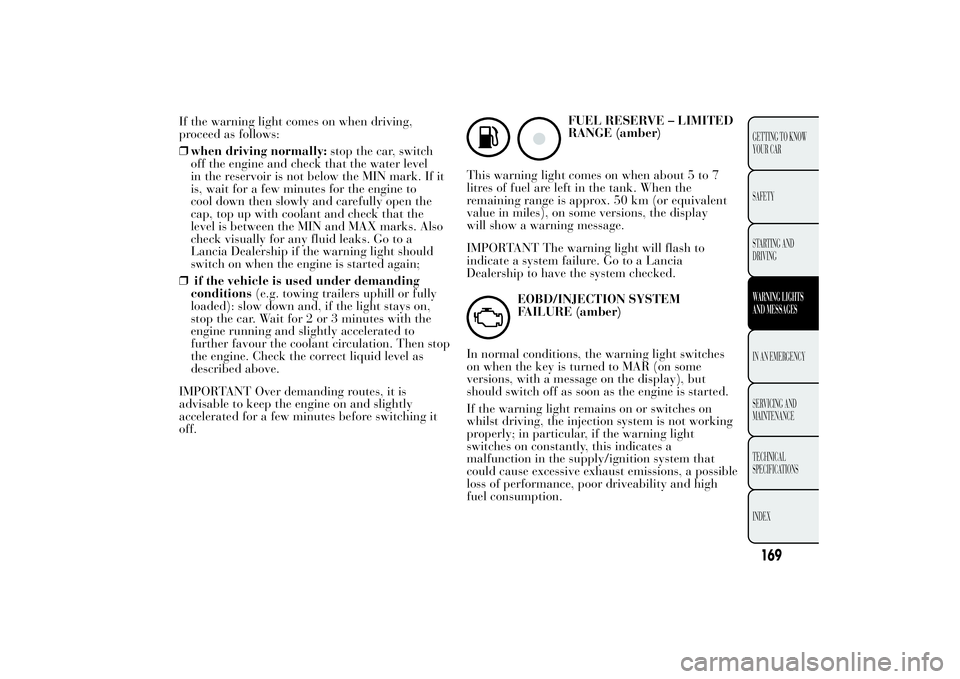
If the warning light comes on when driving,
proceed as follows:
❒when driving normally:stop the car, switch
off the engine and check that the water level
in the reservoir is not below the MIN mark. If it
is, wait for a few minutes for the engine to
cool down then slowly and carefully open the
cap, top up with coolant and check that the
level is between the MIN and MAX marks. Also
check visually for any fluid leaks. Go to a
Lancia Dealership if the warning light should
switch on when the engine is started again;
❒if the vehicle is used under demanding
conditions(e.g. towing trailers uphill or fully
loaded): slow down and, if the light stays on,
stop the car. Wait for 2 or 3 minutes with the
engine running and slightly accelerated to
further favour the coolant circulation. Then stop
the engine. Check the correct liquid level as
described above.
IMPORTANT Over demanding routes, it is
advisable to keep the engine on and slightly
accelerated for a few minutes before switching it
off.
FUEL RESERVE – LIMITED
RANGE (amber)
This warning light comes on when about 5 to 7
litres of fuel are left in the tank. When the
remaining range is approx. 50 km (or equivalent
value in miles), on some versions, the display
will show a warning message.
IMPORTANT The warning light will flash to
indicate a system failure. Go to a Lancia
Dealership to have the system checked.
EOBD/INJECTION SYSTEM
FAILURE (amber)
In normal conditions, the warning light switches
on when the key is turned to MAR (on some
versions, with a message on the display), but
should switch off as soon as the engine is started.
If the warning light remains on or switches on
whilst driving, the injection system is not working
properly; in particular, if the warning light
switches on constantly, this indicates a
malfunction in the supply/ignition system that
could cause excessive exhaust emissions, a possible
loss of performance, poor driveability and high
fuel consumption.
169GETTING TO KNOW
YOUR CAR
SAFETY
STARTING AND
DRIVINGWARNING LIGHTS
AND MESSAGESIN AN EMERGENCY
SERVICING AND
MAINTENANCE
TECHNICAL
SPECIFICATIONS
INDEX
Page 226 of 315
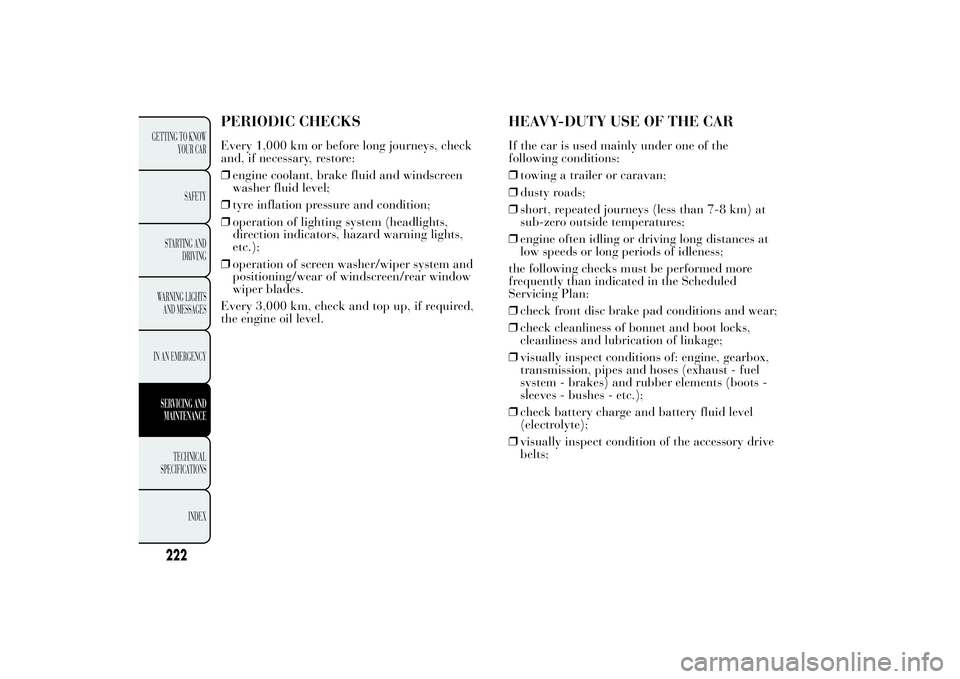
PERIODIC CHECKSEvery 1,000 km or before long journeys, check
and, if necessary, restore:
❒engine coolant, brake fluid and windscreen
washer fluid level;
❒tyre inflation pressure and condition;
❒operation of lighting system (headlights,
direction indicators, hazard warning lights,
etc.);
❒operation of screen washer/wiper system and
positioning/wear of windscreen/rear window
wiper blades.
Every 3,000 km, check and top up, if required,
the engine oil level.
HEAVY-DUTY USE OF THE CARIf the car is used mainly under one of the
following conditions:
❒towing a trailer or caravan;
❒dusty roads;
❒short, repeated journeys (less than 7-8 km) at
sub-zero outside temperatures;
❒engine often idling or driving long distances at
low speeds or long periods of idleness;
the following checks must be performed more
frequently than indicated in the Scheduled
Servicing Plan:
❒check front disc brake pad conditions and wear;
❒check cleanliness of bonnet and boot locks,
cleanliness and lubrication of linkage;
❒visually inspect conditions of: engine, gearbox,
transmission, pipes and hoses (exhaust - fuel
system - brakes) and rubber elements (boots -
sleeves - bushes - etc.);
❒check battery charge and battery fluid level
(electrolyte);
❒visually inspect condition of the accessory drive
belts;
222
GETTING TO KNOW
YOUR CAR
SAFETY
STARTING AND
DRIVING
WARNING LIGHTS
AND MESSAGES
IN AN EMERGENCYSERVICING AND
MAINTENANCE
TECHNICAL
SPECIFICATIONS
INDEX